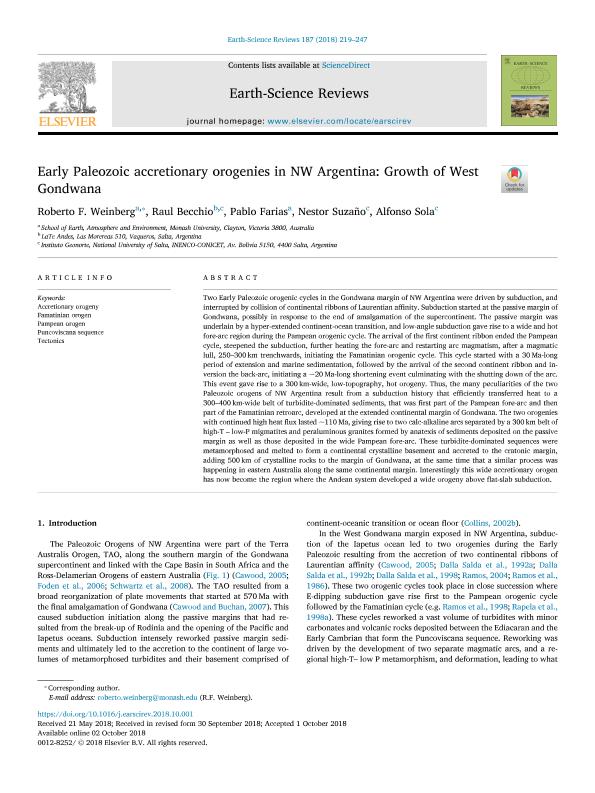Mostrar el registro sencillo del ítem
dc.contributor.author
Weinberg, Roberto F.

dc.contributor.author
Becchio, Raul Alberto

dc.contributor.author
Farias, Pablo
dc.contributor.author
Suzaño, Nestor Omar

dc.contributor.author
Sola, Alfonso Manuel

dc.date.available
2019-12-30T16:37:55Z
dc.date.issued
2018-12
dc.identifier.citation
Weinberg, Roberto F.; Becchio, Raul Alberto; Farias, Pablo; Suzaño, Nestor Omar; Sola, Alfonso Manuel; Early Paleozoic accretionary orogenies in NW Argentina: Growth of West Gondwana; Elsevier Science; Earth-science Reviews; 187; 12-2018; 219-247
dc.identifier.issn
0012-8252
dc.identifier.uri
http://hdl.handle.net/11336/93262
dc.description.abstract
Two Early Paleozoic orogenic cycles in the Gondwana margin of NW Argentina were driven by subduction, and interrupted by collision of continental ribbons of Laurentian affinity. Subduction started at the passive margin of Gondwana, possibly in response to the end of amalgamation of the supercontinent. The passive margin was underlain by a hyper-extended continent-ocean transition, and low-angle subduction gave rise to a wide and hot fore-arc region during the Pampean orogenic cycle. The arrival of the first continent ribbon ended the Pampean cycle, steepened the subduction, further heating the fore-arc and restarting arc magmatism, after a magmatic lull, 250–300 km trenchwards, initiating the Famatinian orogenic cycle. This cycle started with a 30 Ma-long period of extension and marine sedimentation, followed by the arrival of the second continent ribbon and inversion the back-arc, initiating a ~20 Ma-long shortening event culminating with the shutting down of the arc. This event gave rise to a 300 km-wide, low-topography, hot orogeny. Thus, the many peculiarities of the two Paleozoic orogens of NW Argentina result from a subduction history that efficiently transferred heat to a 300–400 km-wide belt of turbidite-dominated sediments, that was first part of the Pampean fore-arc and then part of the Famatinian retroarc, developed at the extended continental margin of Gondwana. The two orogenies with continued high heat flux lasted ~110 Ma, giving rise to two calc-alkaline arcs separated by a 300 km belt of high-T – low-P migmatites and peraluminous granites formed by anatexis of sediments deposited on the passive margin as well as those deposited in the wide Pampean fore-arc. These turbidite-dominated sequences were metamorphosed and melted to form a continental crystalline basement and accreted to the cratonic margin, adding 500 km of crystalline rocks to the margin of Gondwana, at the same time that a similar process was happening in eastern Australia along the same continental margin. Interestingly this wide accretionary orogen has now become the region where the Andean system developed a wide orogeny above flat-slab subduction.
dc.format
application/pdf
dc.language.iso
eng
dc.publisher
Elsevier Science

dc.rights
info:eu-repo/semantics/openAccess
dc.rights.uri
https://creativecommons.org/licenses/by-nc-nd/2.5/ar/
dc.subject
ACCRETIONARY OROGENY
dc.subject
FAMATINIAN OROGEN
dc.subject
PAMPEAN OROGEN
dc.subject
PUNCOVISCANA SEQUENCE
dc.subject
TECTONICS
dc.subject.classification
Geología

dc.subject.classification
Ciencias de la Tierra y relacionadas con el Medio Ambiente

dc.subject.classification
CIENCIAS NATURALES Y EXACTAS

dc.title
Early Paleozoic accretionary orogenies in NW Argentina: Growth of West Gondwana
dc.type
info:eu-repo/semantics/article
dc.type
info:ar-repo/semantics/artículo
dc.type
info:eu-repo/semantics/publishedVersion
dc.date.updated
2019-10-18T18:26:51Z
dc.journal.volume
187
dc.journal.pagination
219-247
dc.journal.pais
Países Bajos

dc.journal.ciudad
Amsterdam
dc.description.fil
Fil: Weinberg, Roberto F.. Monash University; Australia
dc.description.fil
Fil: Becchio, Raul Alberto. Consejo Nacional de Investigaciones Científicas y Técnicas. Centro Científico Tecnológico Conicet - Salta. Instituto de Investigaciones en Energía no Convencional. Universidad Nacional de Salta. Facultad de Ciencias Exactas. Departamento de Física. Instituto de Investigaciones en Energía no Convencional; Argentina
dc.description.fil
Fil: Farias, Pablo. Monash University; Australia
dc.description.fil
Fil: Suzaño, Nestor Omar. Universidad Nacional de Jujuy. Instituto de Geología Minera; Argentina. Consejo Nacional de Investigaciones Científicas y Técnicas. Centro Científico Tecnológico Conicet - Salta. Instituto de Investigaciones en Energía no Convencional. Universidad Nacional de Salta. Facultad de Ciencias Exactas. Departamento de Física. Instituto de Investigaciones en Energía no Convencional; Argentina
dc.description.fil
Fil: Sola, Alfonso Manuel. Consejo Nacional de Investigaciones Científicas y Técnicas; Argentina. Universidad Nacional de Salta. Facultad de Cs.naturales. Cátedra de Petrología Geonorte; Argentina
dc.journal.title
Earth-science Reviews

dc.relation.alternativeid
info:eu-repo/semantics/altIdentifier/doi/http://dx.doi.org/10.1016/j.earscirev.2018.10.001
dc.relation.alternativeid
info:eu-repo/semantics/altIdentifier/url/https://www.sciencedirect.com/science/article/abs/pii/S001282521830309X
Archivos asociados
